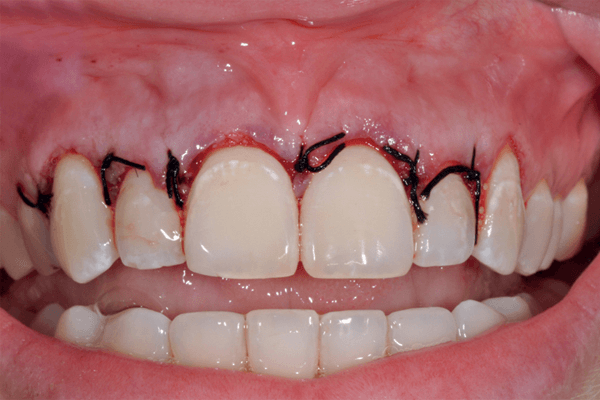RESUMO
A erupção dentária passiva é um processo secundário no qual ocorre a migração gengival para a direção apical. Quando ocorre uma falha nessa migração, o processo é chamado de erupção passiva alterada, o que pode determinar a presença de coroas dentárias curtas ou quadradas e/ou excesso de gengiva ao sorrir, com impacto estético negativo. Em alguns casos, a correção pode ser feita pelo aumento da coroa estético com o auxílio da oxigenoterapia, que promove melhora e agiliza a cicatrização. O objetivo deste relato de caso foi descrever a cicatrização da gengiva após um procedimento de aumento de coroa estético devido à erupção passiva alterada, com o uso de oxigênio ativo no pós-operatório. Paciente do sexo feminino, com 27 anos de idade, procurou a clínica de uma universidade privada com queixa de sorriso gengival. Durante a anamnese, pôde-se observar que ela tinha erupção passiva alterada, sendo então planejada a cirurgia de aumento de coroa estético. Foi realizada a intervenção cirúrgica com osteoplastia do osso alveolar e respeito aos 3 mm de espaço biológico e à correta anatomia de um arco côncavo regular. Foi prescrito enxaguatório bucal à base de oxigênio ativo para auxiliar na cicatrização. Após um acompanhamento de 14 dias, a paciente retornou à consulta de proservação e relatou estar satisfeita com o resultado do procedimento, mais confiante e com melhora da autoestima. Concluiu-se que a utilização da oxigenoterapia auxiliou na melhora da cicatrização gengival após a cirurgia de aumento de coroa estético, mostrando um ótimo resultado pós-operatório e proporcionando ganhos estético e de saúde periodontal, com impacto na qualidade de vida da paciente.
Palavras-chave – Cirurgia bucal; Periodontia; Cuidados pós-operatórios.
ABSTRACT
Passive tooth eruption is a secondary process, in which gingival migration to the apical direction occurs. When this migration fails, the process is called altered passive eruption, which can determine the presence of short or square dental crowns and/or excess gingiva when smiling, with a negative aesthetic impact. In some cases, the correction can be made by increasing the aesthetic crown, with the help of oxygen therapy, which promotes improvement and speeds up healing. The aim of this case report was to describe the healing of the gingiva after an aesthetic crown augmentation procedure due to altered passive eruption, with the use of active oxygen in the postoperative period. A 27-year-old female patient sought the clinic of a private university complaining of gummy smile. During the anamnesis, it was possible to observe that the patient had an altered passive eruption, and an aesthetic crown augmentation surgery was then planned. Surgical intervention was performed, with osteoplasty of the alveolar bone, respecting the 3 mm of biological space and the correct anatomy of a regular concave arch. Active oxygen-based mouthwash was prescribed to aid healing. After a 14-day follow-up, the patient returned to the follow-up appointment and reported being satisfied with the result of the procedure, more confident and with improved self-esteem. It was concluded that the use of oxygen therapy helped to improve gingival healing after cosmetic crown augmentation surgery, showing a great postoperative result, providing an aesthetic gain and periodontal health, with an impact on the patient’s quality of life.
Key words – Oral surgery; Periodontics; Postoperative care.
Referências
- Deliberador TM, Vieira JS, Lopes TR, Giovanini AF, Zielak JC, Brambilla CFF. Cirurgia plástica periodontal para correção de sorriso gengivoso. PerioNews 2013;7(3):281-6.
- Araújo M, Kina S, Brugera A. Manejo do sorriso gengivoso. Rev Dental Press Periodontia Implantod 2007;1(1):68-75.
- American Academy of Periodontology. Glossary of periodontal terms (4ª ed.). Chicago: American Academy of Periodontology, 2001. p.17.
- Garber DA, Salama MA. The aesthetic smile: diagnosis and treatment. Periodontol 2000 1996;11:18-28.
- Mele M, Felice P, Sharma P, Mazzotti C, Bellone P, Zucchelli G. Esthetic treatment of altered passive eruption. Periodontol 2000 2018;77(1):65-83.
- Sánchez IM, Gaud-Quintana S, Stern JK. Modified lip repositioning with esthetic crown lengthening: a combined approach to treating excessive gingival display. Int J Periodontics Restorative Dent 2017;37(1):130-4.
- Imano MH, Chaves LH, Storrer CLM, Amaral CF, Candido BF, Deliberador TM. Uso do gel de oxigênio como otimizador da cicatrização tecidual em áreas doadoras e receptoras na técnica de enxerto gengival livre. INPerio 2019;4(6):1161-9.
- Stroparo JLO, Weiss SG, Storrer CLM, Deliberador TM. Application of an active oxygen (blue®m) with free connective graft technique for root coverage – a case report. RSD 2021;0(5):e57510515468.
- Sukekava F, Carmo Filho LC, Luiz JH, Luiz J. Utilização do Blue®m no tratamento do líquen plano oral – relato de caso. FullDent Sci 2021;12(46):44-8.
- Alpiste-Illueca F. Altered passive eruption (APE): a little-known clinical situation. Med Oral Patol Oral Cir Bucal 2011;16(1):e100-4.
- Schreml S, Szeimies RM, Prantl L, Karrer S, Landthaler M, Babilas P. Oxygen in acute and chronic wound healing. Br J Dermatol 2010;163(2):257-68.
- Mattei BM, Imanishi SAW, Ramos GO, de Campos PS, Weiss SG, Deliberador TM. Mouthwash with active oxygen (blue®m) reduces postoperative inflammation and pain. Case Rep Dent 2021;2021:5535807.
- Stroparo JL, Stroparo GF, Giovanini AF, Baratto-Filho F, Forcada SMBL, Gabardo MCL et al. Enucleation of a cystic lesion in mandible associated with oxygen therapy and bone grafting: case report. EC Dental Science 2021;20(9):111-6.





